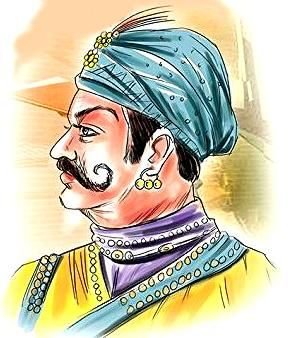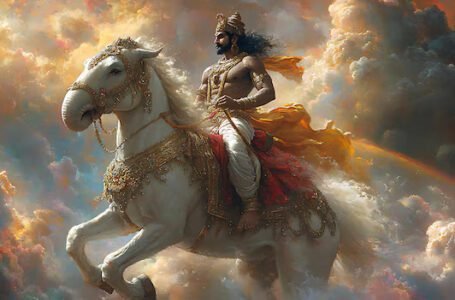Prithviraj Chauhan – The Rajputana Warrior King of Sapadalaksha

Prithviraj Chauhan – A medieval Arjuna who shot a fish eye to wed his love, Samyukta.
Born in 1166 CE to the Chauhan line was one of the greatest warrior kings of medieval India who reigned over Ajmer in 12th century. Prithviraj Chauhan (Prithviraj III), also known as Rai Pithora ruled the Chauhan dynasty for 25 years to make it one of the most powerful dynasties in India. “Chauhan” was derived from the name Chahamanas which was associated with various Rajput clans in Rajasthan.
Chauhan dynasty was founded by Vasudeva Chauhand in 551 AD. Prithviraj was born to Someshwar Chauhan and Karupuradevi in Gujarat and had a sibling by the name Hariraja. His father died when he was 11 and Prithviraj had to take the throne with his mother was acting as regent.

Kingdom and Wars:
Prithviraj grew up seeing the arch rival Nagas getting annihilated by the masterplan of his mother. Ascending the throne at a young energetic age and functioning under the tutelage of his own mother, he went on to become an ambitious warrior ruler to expand as well as to defend his land.
The first struggle that was put to rest happened inside his own family. His rebel cousin Nagarjuna had to be suppressed and the territory of Gudapura was to be restored. The onslaught was so fierce, the gates of the Ajmer fort was decorated by the garland made of heads of the fallen soldiers. Prithviraj then went on to bring his neighbours into submissiveness.
Bhadanaka Kingdom included the present-day Haryana and Alwar region of Rajasthan. Chauhans with their idea of Digvijaya wanted to establish an empire in the North and in the process had to fight with Bhadanakas. (Digvijaya means conquering all the four quarters). Prithviraj is said to have put an end to all the conquest ambitions of Bhadanakas as we do not hear anything them then on.
Meanwhile, the ongoing tussle with Chalukyas of Gujarat flared up during his reign in 1184. In the ensuing war between Prithviraj and Bhimdev II, the Prime Minister of Chalukya, a peace treaty was signed. This had put an end to the long rivalry.
Next in line was the Bundelkhand ruling dynasty Chandelas. However, this time the battle was not planned. Prithviraj’s army was left disoriented after an ambush by the Ghurids. During their retreat they camped at Mahoba which was capital of Chandelas. Mistaking it as a plot, Chandelas started attacking the already weak Prithviraj’s army. Left with no option, they retreated in humiliation. Prithviraj wanted to avenge this debacle. He recouped his army and attacked Chandelas making its ruler Paramardin Deva to flee. What happened later on was not accurately documented but nevertheless Chandelas suffered a humiliating defeat. This however earned Prithviraj more enemies as Chandelas joined hands with Gahavadalas to pose a bigger threat.
Now came the most important battle, the Battle of Tarain (1191) which was fought against Muhammad Ghori, the ruler of the Ghurid dynasty. Ghurids were of Persian ruling clan who invaded India from the North-Western side.

The two forces met near Tarain. Although Prithviraj registered a brilliant victory, he failed to consolidate as he did not anticipate frequent attacks by the Ghurids. Despite being injured, Ghori was carried to safety by his horseman.
Muhammad Ghori made serious preparations and gathered a sizable army while Prithviraj was complacent. In 1192, Ghori travelled through Peshawar and Multan to reach Lahore with his troop. He asked Prithiviraj to accept his dominance and convert to Islam in a message that he sent to him. However, Prithiviraj turned down the offer and organised his army to repel the invader. He was also accompanied by other Hindu rulers and chieftains. Underestimating the strength of the resistance, Prithviraj committed a catastrophic mistake. In this Second Battle of Tarain, Prithviraj was completely destroyed and ultimately captured. He was reinstated to his throne in Ajmer by Ghori. However, he was later put to death on treason accusations, and Qutb-ud-din Aibak, Ghori’s dependable general was named as his replacement in India. Meanwhile Govindaraja IV the son of Prithviraj gave up the region of Ajmer to the Ghurids, essentially making it a vassal state.
The Rajputs also suffered a terrible defeat in the second battle of Tarain. Their standing in politics took a significant hit. The entire Chauhan kingdom was totally under the control of the invader. Thus, Ajmer saw the establishment of the first Muslim kingdom in India, ushering in a new chapter in the country’s history.

Muhammad Ghori returned to Ghazni following his victory over Prithiviraj at Tarain, to address the threat posed by the Turks and Mongols. Qutb-ud-din Aibak, who had been left behind in India after Ghori’s death in 1206, took control of his domains there and proclaimed himself the First Sultan of Delhi.
Conclusion
Prithviraj was not all wars and bloodsheds. His personal life was also keenly discussed and made into poems. Although known for his strategic alliances with other rulers, the love that blossomed on the daughter of one of his foes and then be able to impress her dad later on, was a remarkable feat. An epic folklore mentions about an incident wherein Prithviraj participating in swayamvar. in which he had successfully had hit the eye of a moving image of fish. Although it was not corroborated by facts, this could have been inspired by Arjuna from Mahabharata.

A few centuries later, Chand Bardai, a bard, produced the lengthy epic poem Prithviraj raso. The narrative goes as follows: The daughter of the Kanauj king Jaichand, Samyukta was destined for marriage. In order to give the bride, the option of selecting her own husband, a suyamwara was held. But she wished to wed Prithiviraj as she was in love with him. He was also her father’s nemesis. Jaichand insulted him by refusing to invite the latter and also by erecting a statue of Prithiviraj to serve as the doorman at his court. To the surprise of everyone there, the princess Samyukta chose to garland the statue of Prithiviraj. Prithiviraj, who had been hiding nearby, leaped in and mounted a horse to ride off with the princess. A battle ensued and Prithviraj side won it. After the success, Samyukta and Prithviraj got married.


